
Home |
Technical |
Up |
Next |
Prev |
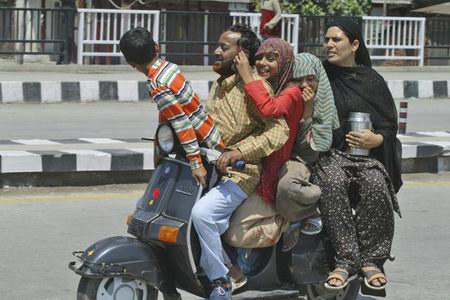
All hardware has its limits.
Shutter Speed
The simplest way to gather more photons per pixel and thus improve image quality is to leave the shutter open longer. Simple! Yes, you could make a 20MP camera phone, with quality optics, mount it on a tripod and take long exposure scenery shots to rival Ansell Adams. You could even take a photo of a still typewriter in the dark of a museum and get tack sharp results with an exposure of 5 minutes. Like totally awesome man!
However, such things are of little use in the real world. In the real world most subjects move. Especially people, who comprise the great majority of shots. Unless you can persuade the subject to hold very still, your minimum exposure time is around 1/60 sec (Image Stabilisation does not help here). This will be roughly adequate for people who are largely stationary, but for people in action you will need a much shorter exposure, typically 1/1,000 sec.
1/60 sec is the critical indoor exposure, as it represents the best tradeoff between the exposure you need for people and exposure you need for quality. For this reason I set up the all important first table around it.
Colour Detection
All of the preceding analysis has assumed that there is only one photodetector per pixel, that can detect all colours, but in fact most sensors can only detect 1 colour per pixel. In conventional sensors colour filters are placed over the photodetectors in a rectangular array known as a Bayer filter mosaic. One each for red, green and blue, and an extra green detector to make a square. There are also other filter arrangements, for example the CYGM filter (cyan, yellow, green, magenta) and the RGBE filter (red, green, blue, emerald).
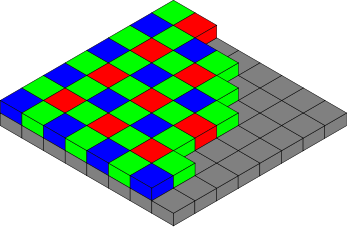
Bayer Filter Mosaic
There are two problems with this approach:
- You need to use 4 pixels to get all the colour information for each pixel which means a loss in resolution by a factor of 4. Camera Manufacturers have got around this by "interpolating" the missing colour information in each pixel based on the pixels around it. This process is also known as "demosaicing". It's true that today's demosaicing algorithms guess correctly much of the time, but not all the time. It's only a guess and it will get it wrong when it comes to irregular fine detail.
- The coloured filter absorbs 2/3 of the wavelengths and hence 2/3 of the incoming photons. the transmissivity of the filter for the colours allowed through is still not perfect so the amount of afferent light actually hitting the sensor is not much more than 1/4. When you consider the loss due to the anti-aliasing filter there is a clear 2 stop penalty at the sensor.
Naturally camera manufacturers have been aware of this stumbling block since the beginning of digital photography and various inventions have sought to get around it. Most notably there are:
- Foveon's Quantum Colour Absorption scheme: which uses the fact that different wavelengths are absorbed at different depths in the silicon wafer to get all the colour information from one photosite (really 3 photodetectors stacked vertically),
- Nikon's Dichroic Colour Separation scheme: which uses an array of micro lenses to focus the afferent rays to a size less than a quarter of their impinging size, these rays are then split by dichroic mirrors and directed to sub-pixels where the colour data is recorded.
Intuitively I can see that Foveon's system is the most elegant, but is likely to suffer from poor wavelength partition discrimination. Nikon's system on the other hand, looks complex, difficult and expensive to implement, but if it can be made to work, it may eventually yield the best results.
As of mid 2009, only Foveon's X3 system is actually in use, but it is struggling to approach the efficiency of even the Bayer Mosaic. So for the time being at least, we must accept a 2 stop penalty for colour detection implementation over the theoretical value.
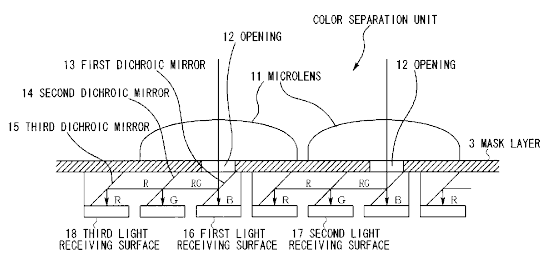
Nikon's Patented Dichroic Sensor Design
Aperture
The quickest way to reduce one's photon count is to not let them all hit the sensor. We do this with our aperture control that causes the lens iris to block off most of the incoming photons. Each stop of aperture cuts off half of the photons remaining at the last stop. Conversely the simplest way to get more photons is to open up the aperture, letting more photons in. Perhaps this is the answer to our photon problems? Can't we just make bigger lenses? ... Sadly no. There are limits to maximum aperture and to useful aperture, so again, you can only lose.
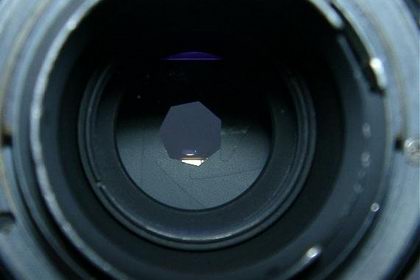
Lens Diaphragm
It can be shown that the aperture at which the brightness of the object is equal to the brightness of the image is f/0.5. This is also the maximum aperture possible according to Herr Abbe and his sine condition. What this means is that light amplification cannot be achieved through optics alone. The most you can hope for is equal brightness at the sensor provided you have an f/0.5 lens...
For each stop beyond 0.5 you lose another half of the theoretically available light. F/5.6 is the 7th stop on the perfect lens aperture ring (ie an f/0.5 lens1), this means you are letting through only 2-7 of the available photons, ie 1/128. Obviously this is going to make things very difficult in even moderately low-light situations. So why don't we just use sub f/1.0 lenses and be done with it?
Yes, it is possible, (though difficult), to make such lenses for SLRs. Zeiss made a few 50mm f/0.7 lenses for NASA, just 1 stop from ideal, which were later used by Stanley Kubrick to film actors in candlelight. This sounds great but it is not the answer, at least for not the normal SLR photographer. Such lenses are impractical on SLRs because they are large, heavy and expensive and most conclusively, produce extreme narrow DoF. These problems would be less severe with small format sensors so they might yet appear in a compact, don't hold your breath.
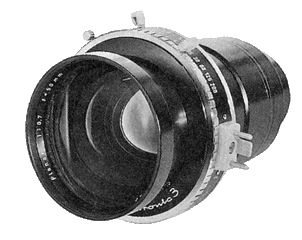
The Zeiss Planar T 50mm f/0.7
Photographers interested in low-light work DO use f/1.4 prime lenses which gives them the speed they need, however, the Depth Of Field of SLR cameras at low f stop numbers is VERY narrow. A closeup of a face at f/1.4 will not show all the face in focus for example. Similarly, group shots at f/1.4 with a 35mm or 50mm focal length are generally out of the question also, unless you can get the group to line up very precisely. This is not generally realistic, so unless you are prepared to turn OoF2 into a positive you need close the aperture down to at least f/2.8 on an SLR for most shots.
Incidentally, no one makes an f/1.0 lens for SLR anymore. Canon did, but it was heavy and expensive and they discontinued it. Leica currently offer a 50mm f/0.95 lens, but that is for rangefinder mount. It is 75mm long, 73mm wide and weighs 700 grams. Sub f/2.8 lenses are generally limited to 100mm and shorter focal lengths. Theoretically it may be possible to build a 400mm f/1.0 lens, but can you imagine the size and weight!!!
Interestingly, DoF increases with reduction in sensor size, so that a compact digicam, shooting at f/2.8 can exhibit a DoF greater than that of an SLR shooting at f/8. This gives compacts a terrific advantage in the low light stakes that goes quite a way to making up for their pathetic pixel pitch. Way back in 2003 the Canon G5 offered an aperture of f/2.0 and reasonable pixel pitch, making it a real SLR beater for those who want reasonable DoF, (or it would be with modern electronics). Sadly Canon discontinued that lens a year or so later and reduced the pixel size. As of late 2009 there are only 2 digicams that offer a comparable aperture, the great majority are WAY behind! But that's progress.
It's difficult to put an exact figure on it, because adequate DoF varies from shot to shot and depending on what the photographer is trying to achieve, but for most work I'll be generous and say that you need at least f/2.8 for an SLR and (I would guess) f/1.4 for a compact. That's at least a 5 stop penalty for the SLR and a 3 stop penalty for the compact. These are limitations based on the laws of optics, you can't get around them! Bad huh!
Electron Full Well Capacity & ADC Resolution
Each pixel can only hold so many electrons (roughly equivalent to their photon count) before they start to leak across the boundaries, this limit is called the Full Well Capacity. I have not studied this subject but according to Roger Clark the full well capacity of today's sensors is about 1,700 electrons per square micron. A 10 MP SLR has therefore a maximum photon count per pixel of about 50,000. This is considerably more than 4,096 but a LONG way short of the 1,000,000 that is required for perfection. This does not intrude additional loss but it does impose an upper limit on quality. Whether this limit can eventually be raised to one million I don't know.
The maximum ADC resolution in today's cameras is only 14 bits or 16,000. You might think that since this is a LONG way short of 1,000,000, that it might impose a serious constraint on achieving perfection. However, in fact it is not critical, since the count can be square compressed prior to digital conversion. After compression 12 bits of resolution is more than enough for perfection.
Hardware Inefficiencies
The above limitations have been theoretical, assuming perfect components, but of course, even in the best cameras, components are not perfect.
- To begin with there is the main lens
- Then there are the microlenses
- Then there is the sensor itself
- Then there is the ADC and gain circuitry...
With so many optical components the transmission losses will always be substantial. I'll admit that I don't know the actual figures but I'll be generous and say that a 50% loss would be the best we could hope for. That's 1 stop.
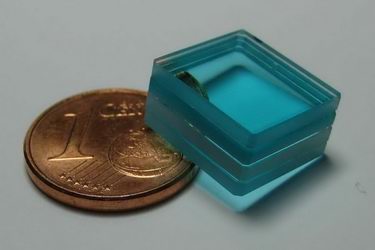
An Anti-Aliasing Filter
So What's The Damage?
For an SLR: allowing 5 stops for the aperture loss, 2 for the Bayer and AA filters and 1 stop for the hardware inefficiencies, we have a total real world penalty of 8 stops over the theoretical limits from my preceding analysis. ie you need 256 times more photons than theoretical. This means we need about 250 million photons in the bright areas for perfect shots.
For a compact: allowing 3 stops for the aperture loss, 2 for the Bayer and AA filters and 1 stop for the hardware inefficiencies, we have a total real world penalty of 6 stops over the theoretical limits from my preceding analysis. This means we need about 64 million photons in the bright areas for perfect shots.
* Note that this is assuming manufacturers were to use f/1.4 lenses in their compacts (which they haven't done yet). In fact they only use f/2.8 or slower, so for the time being they require the same photon density as SLRs. Since their pixel pitch is much smaller so is the quality, but this is only because they are poorly designed.
250 million photons per pixel is about what an APS sensor SLR will capture in full sun. 64 million is about what a quality compact, (which they don't make), can expect in the same situation. This is fine for outdoors, but it leaves quality indoor shots a long way off. Not good news is it?
(BTW Fascinating is it not? A quality compact provides the same theoretical image quality under real world conditions as an SLR!!! Not many people know this...)
CanTechnology Can Solve This?
- Fully Efficient Sensor: 2 stops of improvement are theoretically available if you get a large advance in sensor technology enabling all the photons per pixel to be counted. But will this happen? Sigma use the Foveon sensor in their cameras, but it is not yet proving to be any more sensitive than the conventional technology. In the short term we can expect no change and realistically the most we can hope for in the long term is probably about 1 stop of improvement.
- Component Inefficiencies: As for the stop penalty due to optical and electronic losses, forget it. You can't make these things perfect. That guess is probably optimistic anyway. Perhaps they might get it down to ½ a stop... Maybe... Don't count on it...
- Depth of Field: The penalty for aperture loss is a theoretical one, the only way to improve it and retain DoF is to use a smaller sensor. Will compacts become the professional's camera of choice? Well not yet because manufacturers aren't trying to make quality compacts anymore, but perhaps in the future?
- Pixel Pitch. To get a 2 stop improvement we need merely make the pixels 4 times bigger. However, this means reducing the number of MegaPixels or increasing the size of the sensor. Sensors larger than 35mm mean large, unwieldy cameras with narrow DoF that are of little use in the real-world. Resolutions need to be at least 2MP to suit today's displays and to allow for cropping 5MP is more realistic. There is some room to manoeuver here. Following the Martian Categorisation Scheme for compacts would yield a 2 stop improvement over the rubbish that is around today, but that would only bring them back to where they should be, you will still have a 6 stop loss. 10MP APS-C SLRs are about right for professional use so there's no real room to move there. 20MP full-frame SLRs have more resolution than needed, so a 10MP 35mm job would give you back 1 of the lost stops, a 5MP version of the same would give back 2 stops, but for professional use this might not be quite enough resolution.
No It Can't!
Considering all of the above, I think it is unrealistic to expect any serious improvement in low-light performance. The best approach is to keep the sensor size up and the Megapixels down as far as is realistically practical but although this will help to optimise IQ it won't solve the 6 and 8 stop dilemma. The best we can hope for is a 2 stop reduction if one of the non-mosaic sensor technologies REALLY hits its straps. Sorry folks, there's no miracle solution to be found here.
By now you are no doubt asking: "So how come they work at all?"
- An f/0.5 lens has the characteristic that the luminous emittance of an object in the real world is equal to the illuminance of the corresponding image at the sensor.
- As many do, particularly the more arty photographers. Still, it is a limitation.